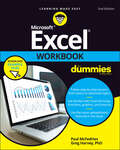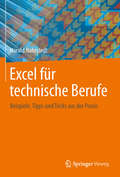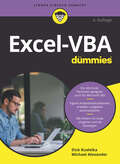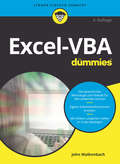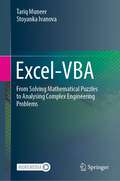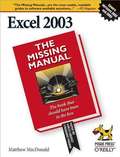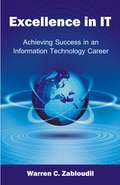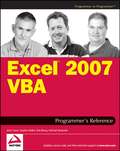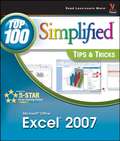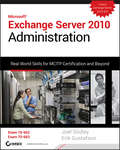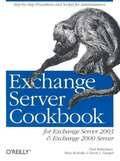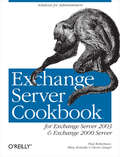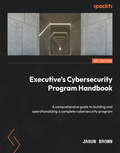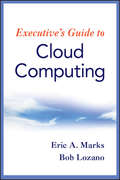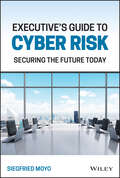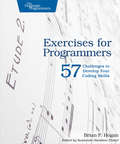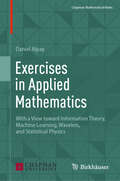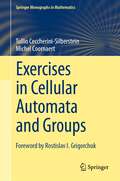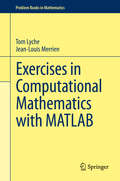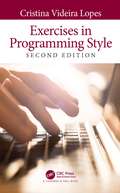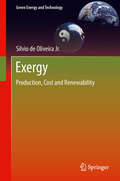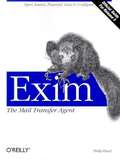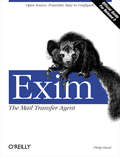- Table View
- List View
Excel Workbook For Dummies
by Greg Harvey Paul McFedriesGet practical walkthroughs for the most useful Excel features Looking for easy-to-understand, practical guidance on how to go from Excel newbie to number crunching pro? Excel Workbook For Dummies is the hands-on tutorial you've been waiting for. This step-by-step guide is packed with exercises that walk you through the basic and advanced functions and formulas included in Excel. At your own speed, you'll learn how to enter data, format your spreadsheet, and apply the mathematical and statistical capabilities of the program. Work through the book from start to finish or, if you'd prefer, jump right to the section that's giving you trouble, whether that's data visualization, macros, analysis, or anything else. You can also: Brush up on and practice time-saving keyboard shortcuts for popular commands and actions Get a handle on multi-functional and practical pivot tables with intuitive practice exercises Learn to secure your data with spreadsheet password protections Perfect for new users of Excel, Excel Workbook For Dummies is also the ideal resource for those who know their way around a spreadsheet but need a refresher on some of the more advanced features of this powerful program.
Excel for Starters: The Missing Manual
by Matthew MacdonaldFor PC users who need a quick way to get up to speed on Microsoft Excel, our smart new Missing Manual demystifies spreadsheets and explains how to create them painlessly. The book focuses on the program's most common and useful features, guiding readers through them with clear explanations, step-by-step instructions, lots of illustrations, and friendly, time-saving advice. Like its siblings in the Missing Manual series, the book crackles with a fine sense of humour and refreshing objectivity about its subject. It's a perfect primer for readers who want to organize household and office information with Excel, and small businesses with no techie to turn to.
Excel für technische Berufe: Beispiele, Tipps und Tricks aus der Praxis
by Harald NahrstedtEs werden alle Methoden in Excel beschrieben, die keiner Programmierung bedürfen. Anhand von Praxisbeispielen aus vielen Bereichen der Technik z. B. Elektronik oder technische Chemie wird der effektive Einsatz der Methoden unter Excel beschrieben. Dieses Arbeitsbuch ist eine Ergänzung zum bestehenden Buch Excel + VBA desselben Autors.
Excel-VBA für Dummies (Für Dummies)
by Michael Alexander Dick KusleikaUm noch mehr aus Excel herauszuholen, sind Kenntnisse der VBA-Programmierung von groà em Vorteil: Dann können Sie Excel auf Ihre Bedürfnisse zuschneiden und langweilige Routinearbeiten automatisieren. Dieses Buch zeigt Ihnen zunächst den Umgang mit dem VBA-Editor und gibt einen Einblick in die wichtigsten Programmiertechniken, wie Sie Fehler beseitigen, Range-Objekte einsetzen und den Programmfluss steuern. Lernen Sie dann die vielfältigen Programmiermöglichkeiten kennen. Alle Beispielprogramme und Arbeitsblätter stehen zum Download zur Verfügung. Sie werden staunen: Mit VBA können Sie sich selbst Dialogboxen, Werkzeugleisten und Menüs schneidern. Und das schon nach kurzer Zeit!
Excel-VBA für Dummies (Für Dummies)
by John WalkenbachUm noch mehr aus Excel herauszuholen, sind Kenntnisse der VBA-Programmierung von großem Vorteil: Dann können Sie Excel auf Ihre Bedürfnisse zuschneiden und langweilige Routinearbeiten automatisieren. Dieses Buch zeigt Ihnen zunächst den Umgang mit dem VBA-Editor und gibt einen Einblick in die wichtigsten Programmiertechniken, wie Fehler beseitigen, Range-Objekte einsetzen und den Programmfluss steuern. Lernen Sie dann die vielfältigen Programmiermöglichkeiten kennen. Alle Beispielprogramme und Arbeitsblätter stehen zum Download zur Verfügung. Sie werden staunen: Mit VBA können Sie sich selbst Dialogboxen, Werkzeugleisten und Menüs schneidern. Und das schon nach kurzer Zeit!
Excel-VBA: From Solving Mathematical Puzzles to Analysing Complex Engineering Problems (Springerbriefs In Applied Sciences And Technology Ser.)
by Tariq Muneer Stoyanka IvanovaThis compact text is a powerful introduction to the Excel/VBA computing environment. The book presents some of the most useful features of Excel. First by introducing mathematical puzzles that will grab the reader’s attention with the reader invited to think hard on solving those puzzles. Then, solutions are presented in a logical manner. The book goes on to describe modern and up-to-date engineering problems and their solutions. Based on many years of the authors’ teaching, the book provides a practical, useful and enjoyable learning methods for readers to become expert in Excel and its application to engineering.
Excel: The Missing Manual
by Matthew MacdonaldWhether you are an Excel neophyte, a sophisticate who knows the program inside out, or an intermediate-level plodder, Excel: The Missing Manual will be sure to become your go-to resource for all things Excel. Covering Excel 2002 and 2003, the book is an indispensable guide to one of the most popular and complicated programs. It has all you need to help you excel at Excel.
Excellence in It: Achieving Success in an Information Technology Career
by Warren C. ZabloudilExcellence in IT reminds you that IT is an all or nothing career with too many people depending on you for the job to not be done well at all times. Everyone working in IT should rise to the occasion and seek to deliver the highest quality workmanship possible. The book covers all those things that keep IT professionals awake at night and offers advice on how to work around stress, work easier and faster, deal with problematic personalities, keep up with the never-ending chase for new knowledge, and, ultimately, how to stay competitive in your career for a long, long time. Excellence in IT provides answers to virtually everything a computer career involves and outlines how to rise to the top of your field while looking after your personal happiness too. It's not just another bone dry technical guide, but an easily readable book that explains what you're going through every day on the job and how to make your career work better for you.
Excel© 2007 VBA Programmer's Reference
by John GreenThis book is aimed squarely at Excel users who want to harness the power of the VBA language in their Excel applications. At all times, the VBA language is presented in the context of Excel, not just as a general application programming language. The Primer has been written for those who are new to VBA programming and the Excel object model. It introduces the VBA language and the features of the language that are common to all VBA applications. It explains the relationship between collections, objects, properties, methods, and events and shows how to relate these concepts to Excel through its object model. It also shows how to use the Visual Basic Editor and its multitude of tools, including how to obtain help. The middle section of the book takes the key objects in Excel and shows, through many practical examples, how to go about working with those objects. The techniques presented have been developed through the exchange of ideas of many talented Excel VBA programmers over many years and show the best way to gain access to workbooks, worksheets, charts, ranges, and so on. The emphasis is on efficiency--that is, how to write code that is readable and easy to maintain and that runs at maximum speed. In addition, the chapters devoted to accessing external databases detail techniques for accessing data in a range of formats. The final four chapters of the book address the following advanced issues: linking Excel to the Internet, writing code for international compatibility, programming the Visual Basic Editor, and how to use the functions in the Win32 API (Windows 32-bit Application Programming Interface).
Excel® 2007: Top 100 Simplified® Tips & Tricks
by Denise EtheridgeYou already know Excel 2007. Now you'd like to go beyond with shortcuts, tricks, and tips that let you work smarter and faster. And because you learn more easily when someone shows you how, this is the book for you. Inside, you'll find clear, illustrated instructions for 100 tasks that reveal cool secrets, teach timesaving tricks, and explain great tips guaranteedto make you more productive with Excel 2007. * Minimal text and maximum illustrations * Task-oriented, step-by-step approach * Navigational aids connect instructions to illustrations * Self-contained, two-page lessons * Uniform layout makes it easy to read less, learn more How easy is it? Look for these symbols marking the difficulty of each task. * Demonstrates a new spin on a common task * Introduces a new skill or a new task * Combines multiple skills requiring in-depth knowledge * Requires extensive skill and may involve other technologies
Exchange Server 2010 Administration
by Joel Stidley Erik GustafsonA soup-to-nuts guide for messaging administratorsExchange Server is the world's leading e-mail server software. Windows 7 and Server 2008 R2 have made changes that messaging administrators need to know and understand in their daily work with Exchange Server. This Sybex guide focuses on the skills, concepts, technologies, and potential pitfalls that admins in the trenches need to understand. It also provides the information they need to earn MCITP certification.Updates in Exchange Server, the world's leading e-mail server software, require messaging administrators to update their knowledge in order to provide the best possible e-mail solutions Highly focused and comprehensive, this guide teaches you to design a highly available e-mail messaging server, install and configure Exchange Server 2010, work with recipients, groups and mailboxes, configure public folders, secure Exchange, and more CD includesvideo walkthroughs of more difficult tasks, practice exams, and electronic flashcards. Exchange Server 2010 Administration offers real-world knowledge that messaging admins need every day and helps prepare candidates for the MCITP certification exam.CD-ROM/DVD and other supplementary materials are not included as part of the e-book file, but are available for download after purchase.
Exchange Server Cookbook
by Paul Robichaux Devin Ganger Missy KosloskyAsk network administrators what their most critical computer application is, and most will say "email" without a moment's hesitation. If you run a network powered by Windows 2000 or Windows Server 2003, Microsoft Exchange occupies much of your time. According to Microsoft, 110 million Exchange seats have been deployed, but 60% of you are still running Exchange 5.5. That's a problem, because the difference between version 5.5 and the more efficient Exchange 2000 and Exchange Server 2003 is profound. Don't fret. Exchange Server Cookbook offers you a comprehensive how-to guide to these newer versions of Exchange. You'll find quick solutions for the most common tasks you need to perform--everything from installation and maintenance to configuration and optimization, with proven recipes for the most useful tools and utilities. The book also has solutions to some uncommon tasks (that you may not know are possible) and advanced procedures that aren't part of day-to-day operations. These include tasks for critical situations, such as using a recovery storage group. Our reliable desktop reference even shows you how to write scripts for Exchange management and deployment tasks. That's right. While not every Exchange job can be scripted, many can, and we provide lots of working VBScript examples for accomplishing particular goals. Whatever your particular need, you'll find it quickly, because chapters in this Cookbook are laid out by recipe, with cross references to other pertinent solutions in the book. With this guide, you'll learn: The relationship between Exchange and Active Directory When to use the GUI, the command line, or scripting How to prepare forests, domains, and servers How to use Group Policy to control Exchange Diagnostic logging, measure performance, and administrative privileges Recipient management: user accounts, mailboxes, mail-enabled groups Mailbox and public folder database management Message routing and transport functions Security, backup, restore, and recovery operations For every question you have about Exchange 2000 or Exchange Server 2003, our Cookbook has the answer--one that you can find and implement without a moment's hesitation.
Exchange Server Cookbook
by Paul Robichaux Missy Koslosky Devin L. GangerAsk network administrators what their most critical computer application is, and most will say "email" without a moment's hesitation. If you run a network powered by Windows 2000 or Windows Server 2003, Microsoft Exchange occupies much of your time. According to Microsoft, 110 million Exchange seats have been deployed, but 60% of you are still running Exchange 5.5. That's a problem, because the difference between version 5.5 and the more efficient Exchange 2000 and Exchange Server 2003 is profound. Don't fret. Exchange Server Cookbook offers you a comprehensive how-to guide to these newer versions of Exchange. You'll find quick solutions for the most common tasks you need to perform--everything from installation and maintenance to configuration and optimization, with proven recipes for the most useful tools and utilities. The book also has solutions to some uncommon tasks (that you may not know are possible) and advanced procedures that aren't part of day-to-day operations. These include tasks for critical situations, such as using a recovery storage group. Our reliable desktop reference even shows you how to write scripts for Exchange management and deployment tasks. That's right. While not every Exchange job can be scripted, many can, and we provide lots of working VBScript examples for accomplishing particular goals. Whatever your particular need, you'll find it quickly, because chapters in this Cookbook are laid out by recipe, with cross references to other pertinent solutions in the book. With this guide, you'll learn: The relationship between Exchange and Active Directory When to use the GUI, the command line, or scripting How to prepare forests, domains, and servers How to use Group Policy to control Exchange Diagnostic logging, measure performance, and administrative privileges Recipient management: user accounts, mailboxes, mail-enabled groups Mailbox and public folder database management Message routing and transport functions Security, backup, restore, and recovery operations For every question you have about Exchange 2000 or Exchange Server 2003, our Cookbook has the answer--one that you can find and implement without a moment's hesitation.
Executive's Cybersecurity Program Handbook: A comprehensive guide to building and operationalizing a complete cybersecurity program
by Jason BrownDevelop strategic plans for building cybersecurity programs and prepare your organization for compliance investigations and auditsKey FeaturesGet started as a cybersecurity executive and design an infallible security programPerform assessments and build a strong risk management frameworkPromote the importance of security within the organization through awareness and training sessionsBook DescriptionRansomware, phishing, and data breaches are major concerns affecting all organizations as a new cyber threat seems to emerge every day. making it paramount to protect the security of your organization and be prepared for potential cyberattacks. This book will ensure that you can build a reliable cybersecurity framework to keep your organization safe from cyberattacks.This Executive's Cybersecurity Program Handbook explains the importance of executive buy-in, mission, and vision statement of the main pillars of security program (governance, defence, people and innovation). You'll explore the different types of cybersecurity frameworks, how they differ from one another, and how to pick the right framework to minimize cyber risk. As you advance, you'll perform an assessment against the NIST Cybersecurity Framework, which will help you evaluate threats to your organization by identifying both internal and external vulnerabilities. Toward the end, you'll learn the importance of standard cybersecurity policies, along with concepts of governance, risk, and compliance, and become well-equipped to build an effective incident response team.By the end of this book, you'll have gained a thorough understanding of how to build your security program from scratch as well as the importance of implementing administrative and technical security controls.What you will learnExplore various cybersecurity frameworks such as NIST and ISOImplement industry-standard cybersecurity policies and procedures effectively to minimize the risk of cyberattacksFind out how to hire the right talent for building a sound cybersecurity team structureUnderstand the difference between security awareness and trainingExplore the zero-trust concept and various firewalls to secure your environmentHarden your operating system and server to enhance the securityPerform scans to detect vulnerabilities in softwareWho this book is forThis book is for you if you are a newly appointed security team manager, director, or C-suite executive who is in the transition stage or new to the information security field and willing to empower yourself with the required knowledge. As a Cybersecurity professional, you can use this book to deepen your knowledge and understand your organization's overall security posture. Basic knowledge of information security or governance, risk, and compliance is required.
Executive's Guide to Cloud Computing
by Eric A. Marks Bob LozanoYour organization can save and thrive in the cloud with this first non-technical guide to cloud computing for business leadersIn less than a decade Google, Amazon, and Salesforce.com went from unknown ideas to powerhouse fixtures in the economic landscape; in even less time offerings such as Linkedin, Youtube, Facebook, Twitter and many others also carved out important roles; in less than five years Apple's iTunes became the largest music retailer in North America.They all share one key strategic decision - each of these organizations chose to harness the power of cloud computing to power their drives to dominance. With roots in supercomputing and many other technical disciplines, cloud computing is ushering in an entirely new economic reality - technology-enabled enterprises built on low cost, flexible, and limitless technical infrastructures.The Executive's Guide to Cloud Computing reveals how you can apply the power of cloud computing throughout your enterprise, giving members of the C-suite a detailed look at:Why cloud computing must be a top priority on your company's IT roadmapsHow the drive for scale, lower costs and greater agility is making cloud computing a fiscal and technological imperativeThe relationship between cloud computing and other relevant IT initiativesThe strategic implications of cloud computing for the enterpriseWhere to begin and how to get started integrating cloud computing into your existing operationsNow you can harness cloud computing's potential for your organization. Executive's Guide to Cloud Computing shows you how.
Executive's Guide to Cyber Risk: Securing the Future Today
by Siegfried MoyoA solid, non-technical foundation to help executives and board members understand cyber risk In the Executive's Guide to Cyber Risk: Securing the Future Today, distinguished information security and data privacy expert Siegfried Moyo delivers an incisive and foundational guidance for executives tasked with making sound decisions regarding cyber risk management. The book offers non-technical, business-side executives with the key information they need to understand the nature of cyber risk and its impact on organizations and their growth. In the book, readers will find: Strategies for leading with foresight (as opposed to hindsight) while maintaining the company&’s vision and objectives Focused, jargon-free explanations of cyber risk that liken it to any other business risk Comprehensive discussions of the fundamentals of cyber risk that enable executive leadership to make well-informed choices Perfect for chief executives in any functional area, the Executive&’s Guide to Cyber Risk also belongs in the libraries of board members, directors, managers, and other business leaders seeking to mitigate the risks posed by malicious actors or from the failure of its information systems.
Exercises for Programmers: 57 Challenges to Develop Your Coding Skills
by Brian P. HoganWhen you write software, you need to be at the top of your game. Great programmers practice to keep their skills sharp. Get sharp and stay sharp with more than fifty practice exercises rooted in real-world scenarios. If you're a new programmer, these challenges will help you learn what you need to break into the field, and if you're a seasoned pro, you can use these exercises to learn that hot new language for your next gig.One of the best ways to learn a programming language is to use it to solve problems. That's what this book is all about. Instead of questions rooted in theory, this book presents problems you'll encounter in everyday software development. These problems are designed for people learning their first programming language, and they also provide a learning path for experienced developers to learn a new language quickly.Start with simple input and output programs. Do some currency conversion and figure out how many months it takes to pay off a credit card. Calculate blood alcohol content and determine if it's safe to drive. Replace words in files and filter records, and use web services to display the weather, store data, and show how many people are in space right now. At the end you'll tackle a few larger programs that will help you bring everything together.Each problem includes constraints and challenges to push you further, but it's up to you to come up with the solutions. And next year, when you want to learn a new programming language or style of programming (perhaps OOP vs. functional), you can work through this book again, using new approaches to solve familiar problems.What You Need:You need access to a computer, a programming language reference, and the programming language you want to use.
Exercises in Applied Mathematics: With a View toward Information Theory, Machine Learning, Wavelets, and Statistical Physics (Chapman Mathematical Notes)
by Daniel AlpayThis text presents a collection of mathematical exercises with the aim of guiding readers to study topics in statistical physics, equilibrium thermodynamics, information theory, and their various connections. It explores essential tools from linear algebra, elementary functional analysis, and probability theory in detail and demonstrates their applications in topics such as entropy, machine learning, error-correcting codes, and quantum channels. The theory of communication and signal theory are also in the background, and many exercises have been chosen from the theory of wavelets and machine learning. Exercises are selected from a number of different domains, both theoretical and more applied. Notes and other remarks provide motivation for the exercises, and hints and full solutions are given for many. For senior undergraduate and beginning graduate students majoring in mathematics, physics, or engineering, this text will serve as a valuable guide as theymove on to more advanced work.
Exercises in Cellular Automata and Groups (Springer Monographs in Mathematics)
by Tullio Ceccherini-Silberstein Michel CoornaertThis book complements the authors’ monograph Cellular Automata and Groups [CAG] (Springer Monographs in Mathematics). It consists of more than 600 fully solved exercises in symbolic dynamics and geometric group theory with connections to geometry and topology, ring and module theory, automata theory and theoretical computer science. Each solution is detailed and entirely self-contained, in the sense that it only requires a standard undergraduate-level background in abstract algebra and general topology, together with results established in [CAG] and in previous exercises. It includes a wealth of gradually worked out examples and counterexamples presented here for the first time in textbook form. Additional comments provide some historical and bibliographical information, including an account of related recent developments and suggestions for further reading. The eight-chapter division from [CAG] is maintained. Each chapter begins with a summary of the main definitions and results contained in the corresponding chapter of [CAG]. The book is suitable either for classroom or individual use.Foreword by Rostislav I. Grigorchuk
Exercises in Computational Mathematics with MATLAB
by Tom Lyche Jean-Louis MerrienDesigned to provide tools for independent study, this book contains student-tested mathematical exercises joined with MATLAB programming exercises. Most chapters open with a review followed by theoretical and programming exercises, with detailed solutions provided for all problems including programs. Many of the MATLAB exercises are presented as Russian dolls: each question improves and completes the previous program and results are provided to validate the intermediate programs. The book offers useful MATLAB commands, advice on tables, vectors, matrices and basic commands for plotting. It contains material on eigenvalues and eigenvectors and important norms of vectors and matrices including perturbation theory; iterative methods for solving nonlinear and linear equations; polynomial and piecewise polynomial interpolation; Bézier curves; approximations of functions and integrals and more. The last two chapters considers ordinary differential equations including two point boundary value problems, and deal with finite difference methods for some partial differential equations. The format is designed to assist students working alone, with concise Review paragraphs, Math Hint footnotes on the mathematical aspects of a problem and MATLAB Hint footnotes with tips on programming.
Exercises in Programming Style
by Cristina Videira LopesThe first edition of Exercises in Programming Style was honored as an ACM Notable Book and praised as "The best programming book of the decade." This new edition retains the same presentation but has been upgraded to Python 3, and there is a new section on neural network styles. Using a simple computational task (term frequency) to illustrate different programming styles, Exercises in Programming Style helps readers understand the various ways of writing programs and designing systems. It is designed to be used in conjunction with code provided on an online repository. The book complements and explains the raw code in a way that is accessible to anyone who regularly practices the art of programming. The book can also be used in advanced programming courses in computer science and software engineering programs. The book contains 40 different styles for writing the term frequency task. The styles are grouped into ten categories: historical, basic, function composition, objects and object interactions, reflection and metaprogramming, adversity, data-centric, concurrency, interactivity, and neural networks. The author states the constraints in each style and explains the example programs. Each chapter first presents the constraints of the style, next shows an example program, and then gives a detailed explanation of the code. Most chapters also have sections focusing on the use of the style in systems design as well as sections describing the historical context in which the programming style emerged.
Exergy: Production, Cost and Renewability
by Silvio de Oliveira JuniorBridging the gap between concepts derived from Second Law of Thermodynamics and their application to Engineering practice, the property exergy and the exergy balance can be a tool for analyzing and improving the performance of energy conversion processes. With the exergy analysis it is possible to evaluate the performance of energy conversion processes not only on a thermodynamics basis but also by including production costs and environmental aspects and impacts of the studied processes. This comprehensive approach of the use of energy has, as one of the most important feature, the identification of sustainable ways of energy resources utilization. Based on the fundamentals of the exergy concept, its calculation, graphical representations and exergy balances evaluation, Exergy: Production Cost And Renewability describes the application of detailed exergy and thermoeconomic analysis to power plants and polygeneration systems, petroleum production and refining plants (including hydrogen production), chemical plants, biofuel production routes, combined production of ethanol and electricity, aircraft systems design, environmental impact mitigation processes and human body behavior. The presented case studies aim at providing students, researchers and engineers with guidelines to the utilization of the exergy and thermoeconomic analysis to model, simulate and optimize real processes and industrial plants.
Exhibiting Photography: A Practical Guide to Displaying Your Work
by Shirley ReadYou have the camera, you have the skills, and you have the pictures. Now what? Author Shirley Read expertly leads you through the world of exhibiting your photography one minute detail at a time. From finding a space and designing the exhibition to actually constructing a show and publicizing yourself, every aspect of exhibiting your photography is touched upon and clarified with ample detail, anecdotes, and real life case studies. In this new and expanded second edition, Shirley Read further illuminates the world of social networking, exhibiting, and selling photography online so your work is always shown in the best light. Packed with photos of internationally successful exhibitions, check lists, and invaluable advice, this essential reference guide will help amateur and professional photographers alike successfully showcase their bodies of work with confidence and finesse.
Exim
by Philip HazelExim is the default mail transport agent installed on some Linux systems; it runs on many versions of Unix and is suitable for any TCP/IP network with any combination of hosts and end-user mail software. It is open source, scalable, rich in features, and--best of all--easy to configure. This official guide is written by Philip Hazel, the creator of Exim.
Exim: The Mail Transfer Agent
by Philip HazelExim delivers electronic mail, both local and remote. It has all the virtues of a good postman: it's easy to talk to, reliable, efficient, and eager to accommodate even the most complex special requests. It's the default mail transport agent installed on some Linux systems, runs on many versions of Unix, and is suitable for any TCP/IP network with any combination of hosts and end-user mail software. Exim is growing in popularity because it is open source, scalable, and rich in features such as the following: Compatibility with the calling interfaces and options of Sendmail (for which Exim is usually a drop-in replacement) Lookups in LDAP servers, MySQL and PostgreSQL databases, and NIS or NIS+ services Support for many kinds of address parsing, including regular expressions that are compatible with Perl 5 Sophisticated error handling Innumerable tuning parameters for improving performance and handling enormous volumes of mail Best of all, Exim is easy to configure. You never have to deal with ruleset 3 or worry that a misplaced asterisk will cause an inadvertent mail bomb. While a basic configuration is easy to read and can be created quickly, Exim's syntax and behavior do get more subtle as you enter complicated areas like virtual hosting, filtering, and automatic replies. This book is a comprehensive survey that provides quick information for people in a hurry as well as thorough coverage of more advanced material.
